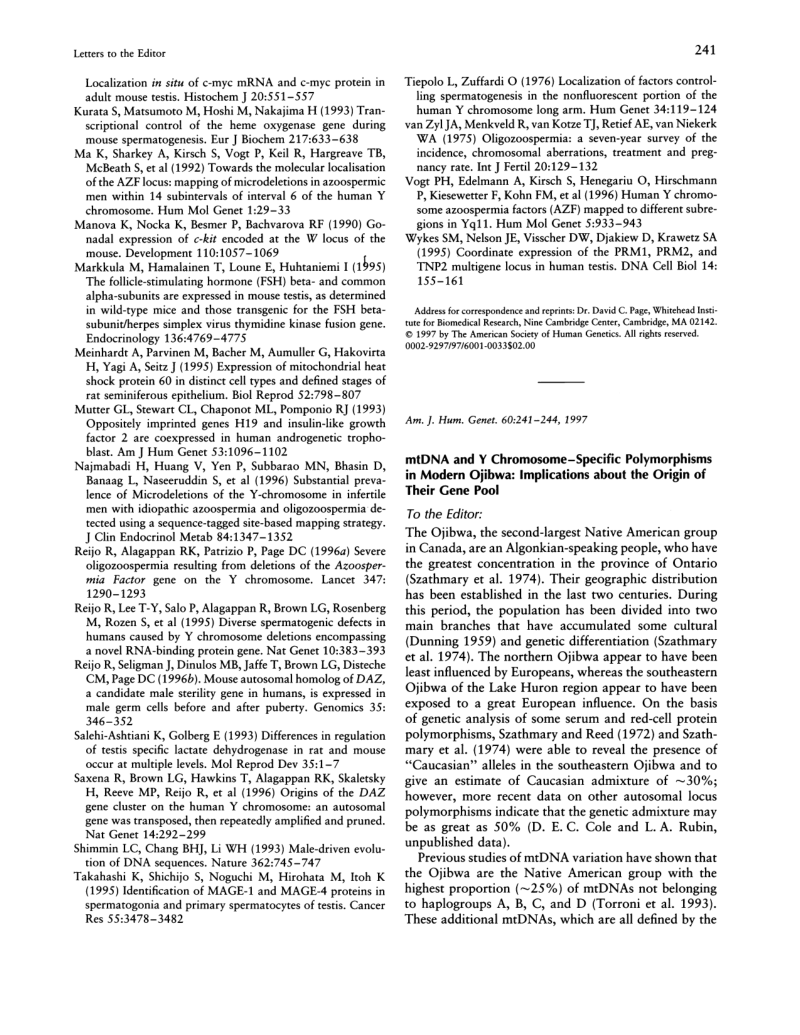Rosaria Scozzari et al. highlight the presence of haplogroup X in North American Native American populations.
- Type
- Academic / Technical Report
- Source
- Rosaria Scozzari et al. Non-LDS
- Hearsay
- Direct
- Reference
Rosaria Scozzari et al., “MtDNA and Y Chromosome-Specific Polymorphisms in Modern Ojibwa: Implications about the Origin of Their Gene Pool,” American Journal of Human Genetics 60 (1997), 241-244
- Scribe/Publisher
- American Journal of Human Genetics
- People
- Rosaria Scozzari et al.
- Audience
- Reading Public
- Transcription
The Ojibwa, the second-largest Native American group in Canada, are an Algonkian-speaking people, who have the greatest concentration in the province of Ontario (Szathmary et al. 1974). Their geographic distribution has been established in the last two centuries. During this period, the population has been divided into two main branches that have accumulated some cultural (Dunning 1959) and genetic differentiation (Szathmary et al. 1974). The northern Ojibwa appear to have been least influenced by Europeans, whereas the southeastern Ojibwa of the Lake Huron region appear to have been exposed to a great European influence. On the basis of genetic analysis of some serum and red-cell protein polymorphisms, Szathmary and Reed (1972) and Szathmary et al. (1974) were able to reveal the presence of "Caucasian" alleles in the southeastern Ojibwa and to give an estimate of Caucasian admixture of -30%; however, more recent data on other autosomal locus polymorphisms indicate that the genetic admixture may be as great as 50% (D. E. C. Cole and L. A. Rubin, unpublished data).
. . .
To gather new data on mtDNA variation in the Ojibwa, we have screened the mtDNAs of 35 subjects from Manitoulin Island in Lake Huron (southeastern Ojibwa) for the marker mutations that define the five Native American haplogroups (table 1). This Ojibwa sample showed haplogroup frequencies not significantly different (two-tailed Fisher's exact test: P _ .06) from those of the Ojibwa from northern Ontario (Torroni et al. 1993), and only two mtDNAs were found to lack the marker mutations that characterize haplogroups A, B, C, D, and X. A detailed screening for the European mtDNA markers (Torroni et al. 1994 and in press) showed that both of these mtDNAs were defined by the AluI site loss at np 7025 and were members of haplogroup H, the most-common European-specific haplogroup. Therefore, mtDNA analysis suggests that only 5.7% of the Ojibwa gene pool can be attributed to Europeans. This finding does not support a strong European genetic influence in modern Ojibwa, unless gene flow had occurred almost exclusively through European males.
- Citations in Mormonr Qnas
The B. H. Roberts Foundation is not owned by, operated by, or affiliated with the Church of Jesus Christ of Latter-day Saints.

